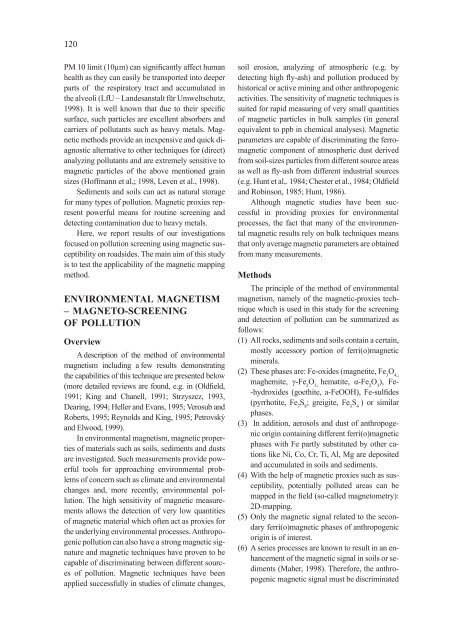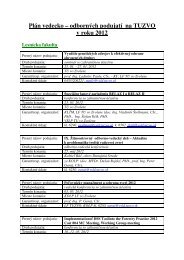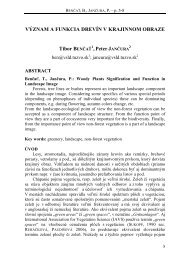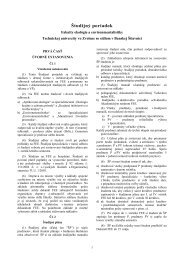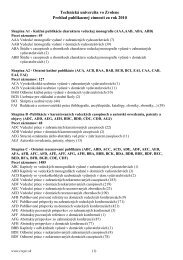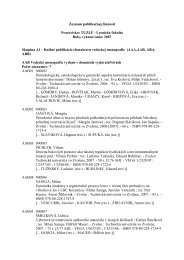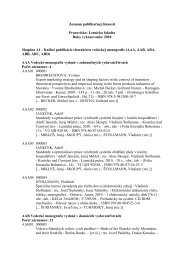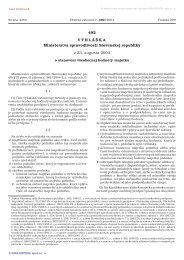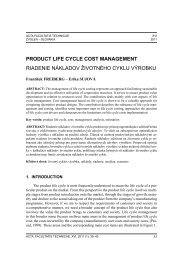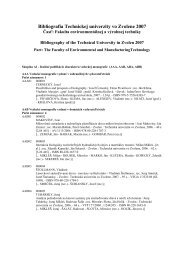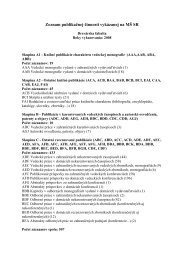119ACTA FACULTATIS ECOLOGIAE, 16: Suppl. 1, 119–123 Z<strong>vo</strong>len (Slovakia), 2007MAGNETIC SUSCEPTIBILITY MAPPING OF ROADSIDEPOLLUTIONDenisa Kľučiarová – D. GregorováGeofyzikálny ústav, Slovenská akadémia vied, Dúbravská cesta 9, 845 28 Bratislava, e-mail: geofdeni@savba.skABSTRACTKľučiarová D. & Gregorová D. Magnetic Susceptibility Mapping of Roadside PollutionIn the last years, several proxy methods have been used to outline increased levels of pollution. Oneof them is based on measurements of the concentration of (ferri)magnetic minerals of antropogenic origin.This approach was successfully applied in several European cities and has shown that magnetic parameters(mainly magnetic susceptibility) can be used as a proxy for heavy metals pollution in topsoils.The aim of our study was to trace the distribution and concentration of contaminants (heavy metals) inthe soil along the road carrying appreciable traffic by using magnetic proxies. The area of this study wasthe part of the main road between Pezinok and Pezinská Baba. We tested how far magnetic measurement ofsoil samples can give information about road soil pollution. The soil samples (very close to the road, 0.5 mand 2m from the road) were collected each 50 m on the 3km long way, air-dried, sieved and measured forthe bulk magnetic susceptibility on the Kappabridge (KLY–2).The results show that the soil samples near the road are characterized by enhanced magnetic susceptibility,with highest values and that the magnetic susceptibility decreases with increasing distance fromthe road. The geochemical analyses revealed the high positive correlation. Therefore the measurement ofmagnetic susceptibility of soils can be – in this case – used as a supplemental method to the geochemicalmapping; method, which allows to assess, in a simple, cheap and rapid way, the level of soil pollution insites, where the geochemical data are missing.Key words: magnetic susceptibility, heavy metals, magnetic screening, pollution of roadside soilsINTRODUCTIONPollution of soils and sediments significantlyreduce environmental quality and affect humanhealth. As a condition for effective protection andremediation actions, the screening and detection ofsoils and sediment pollution has become increasinglyimportant. The pollutants of most concern areheavy metals and organic contaminants.Magnetic techniques were shown to be highlyuseful in investigating industrial pollutants and otheratmospheric aerosols. The intention of magneticstudies of aerosols has been the discrimination offly–ash from other aerosols based on the characteristicmagnetic properties of anthropogenic dusts.Recent studies (Strzyszcz, 1993; Strzyszcz andMagiera, 1998; Petrovský et al,. 1999) demonstratehow a combination of simple magnetic susceptibilitymeasurements can help identify regions wheresoils contain higher than average concentrations offly-ash and other anthropogenic dusts. In additionto fly-ash, there are other numerous atmosphericpollutants such as vehicle and aircraft emissionsor dust from cement production, open pit mining,and steel production. Vehicle emissions have beensuggested to be a significant source of magneticpollutants (Hunt, 1986). However, details about theorigin and the composition of these particles arepresently unknown.Preliminary studies indicate a possible correlationbetween magnetic susceptibility measurementsand atmospheric contaminants. Particles below the
120PM 10 limit (10µm) can significantly affect humanhealth as they can easily be transported into deeperparts of the respiratory tract and accumulated inthe alveoli (LfU – Landesanstalt für Umweltschutz,1998). It is well known that due to their specificsurface, such particles are excellent absorbers andcarriers of pollutants such as heavy metals. Magneticmethods provide an inexpensive and quick diagnosticalternative to other techniques for (direct)analyzing pollutants and are extremely sensitive tomagnetic particles of the above mentioned grainsizes (Hoffmann et al,; 1998, Leven et al., 1998).Sediments and soils can act as natural storagefor many types of pollution. Magnetic proxies representpowerful means for routine screening anddetecting contamination due to heavy metals.Here, we report results of our investigationsfocused on pollution screening using magnetic susceptibilityon roadsides. The main aim of this studyis to test the applicability of the magnetic mappingmethod.ENVIRONMENTAL MAGNETISM– MAGNETO-SCREENINGOF POLLUTIONOverviewA description of the method of environmentalmagnetism including a few results demonstratingthe capabilities of this technique are presented below(more detailed reviews are found, e.g. in (Oldfield,1991; King and Chanell, 1991; Strzyszcz, 1993,Dearing, 1994; Heller and Evans, 1995; Verosub andRoberts, 1995; Reynolds and King, 1995; Petrovskýand Elwood, 1999).In environmental magnetism, magnetic propertiesof materials such as soils, sediments and dustsare investigated. Such measurements provide powerfultools for approaching environmental problemsof concern such as climate and environmentalchanges and, more recently, environmental pollution.The high sensitivity of magnetic measurementsallows the detection of very low quantitiesof magnetic material which often act as proxies forthe underlying environmental processes. Anthropogenicpollution can also have a strong magnetic signatureand magnetic techniques have proven to becapable of discriminating between different sourcesof pollution. Magnetic techniques have beenapplied successfully in studies of climate changes,soil erosion, analyzing of atmospheric (e.g. bydetecting high fly-ash) and pollution produced byhistorical or active mining and other anthropogenicactivities. The sensitivity of magnetic techniques issuited for rapid measuring of very small quantitiesof magnetic particles in bulk samples (in generalequivalent to ppb in chemical analyses). Magneticparameters are capable of discriminating the ferromagneticcomponent of atmospheric dust derivedfrom soil-sizes particles from different source areasas well as fly-ash from different industrial sources(e.g. Hunt et al,. 1984; Chester et al., 1984; Oldfieldand Robinson, 1985; Hunt, 1986).Although magnetic studies have been successfulin providing proxies for environmentalprocesses, the fact that many of the environmentalmagnetic results rely on bulk techniques meansthat only average magnetic parameters are obtainedfrom many measurements.MethodsThe principle of the method of environmentalmagnetism, namely of the magnetic-proxies techniquewhich is used in this study for the screeningand detection of pollution can be summarized asfollows:(1) All rocks, sediments and soils contain a certain,mostly accessory portion of ferri(o)magneticminerals.(2) These phases are: Fe-oxides (magnetite, Fe 3O 4,;maghemite, γ-Fe 2O 3;hematite, α-Fe 2O 3), Fe--hydroxides (goethite, a-FeOOH), Fe-sulfides(pyrrhotite, Fe 7S 8; greigite, Fe 3S 4) or similarphases.(3) In addition, aerosols and dust of anthropogenicorigin containing different ferri(o)magneticphases with Fe partly substituted by other cationslike Ni, Co, Cr, Ti, Al, Mg are depositedand accumulated in soils and sediments.(4) With the help of magnetic proxies such as susceptibility,potentially polluted areas can bemapped in the field (so-called magnetometry):2D-mapping.(5) Only the magnetic signal related to the secondaryferri(o)magnetic phases of anthropogenicorigin is of interest.(6) A series processes are known to result in an enhancementof the magnetic signal in soils or sediments(Maher, 1998). Therefore, the anthropogenicmagnetic signal must be discriminated
- Page 2 and 3:
Acta FacultatisEcologiaeJournal of
- Page 4 and 5:
OBSAH / CONTENTSISOL M., MICHALÍKO
- Page 6:
5ACTA FACULTATIS ECOLOGIAE, 16: Sup
- Page 12:
11ACTA FACULTATIS ECOLOGIAE, 16: Su
- Page 18 and 19:
17ACTA FACULTATIS ECOLOGIAE, 16: Su
- Page 20 and 21:
19are lower in ill patients compare
- Page 22:
21are considered as the most accura
- Page 25 and 26:
24- multimode cavities are usually
- Page 27 and 28:
26the load during its exposure to f
- Page 29 and 30:
28Tradescantia paludosa 02 test and
- Page 31 and 32:
30Tab. 5: Results of positive contr
- Page 34 and 35:
33ACTA FACULTATIS ECOLOGIAE, 16: Su
- Page 36 and 37:
35DISCUSSIONThe ionising radiation
- Page 38 and 39:
37ACTA FACULTATIS ECOLOGIAE, 16: Su
- Page 40 and 41:
39222Rn is produced by radioactive
- Page 42 and 43:
41180160140this reason we also pick
- Page 44:
435001450400350hKz0,8h [m]300250200
- Page 47 and 48:
46deposit is that stripped in off-l
- Page 49 and 50:
48TruenessTrueness was determined i
- Page 51 and 52:
50MATERIAL AND METHODSChloroform (p
- Page 53 and 54:
52absorbance [a.u.]1,000,750,500,25
- Page 55 and 56:
54Tab. 1: Rrequirements determinati
- Page 57 and 58:
56Methods of VOC testing were set a
- Page 60 and 61:
59Tab. 6: ContinuedSamples withsurf
- Page 62 and 63:
61ACTA FACULTATIS ECOLOGIAE, 16: Su
- Page 64 and 65:
63One of the possible explanations
- Page 66 and 67:
65Ai - Ai-1 [Bq.m -3 ]86420-2-4-6-8
- Page 68 and 69:
67ACTA FACULTATIS ECOLOGIAE, 15: Su
- Page 70 and 71: 69BiodegradabilityThe great variety
- Page 72 and 73: 71degradation starts of late days,
- Page 74 and 75: 73Fig. 4 Treated (after 28 days of
- Page 76: 75parameters of the cutting process
- Page 80 and 81: 79Fraction: D (residual rest) prese
- Page 82: 81was not confirmed. Maximum of mer
- Page 85 and 86: 84Fig. 1 Schematic diagram of atomi
- Page 87 and 88: 86Alpha spectrometryAlpha spectrome
- Page 89 and 90: 8880007000y = 6622xR 2 = 0.939SIMS
- Page 92 and 93: 91ACTA FACULTATIS ECOLOGIAE, 16: Su
- Page 94 and 95: 93Gemer according to the German mod
- Page 96 and 97: 95Tab. 1 Results of the chemical an
- Page 98 and 99: 97Continuation of Tab. 2 Results of
- Page 100 and 101: 99Vlčia Dolina and from the reserv
- Page 102 and 103: 101ACTA FACULTATIS ECOLOGIAE, 16: S
- Page 104 and 105: 103mg.dm -3mg.dm -35,004,003,002,00
- Page 106 and 107: 105year and the average value repre
- Page 108 and 109: 107ACTA FACULTATIS ECOLOGIAE, 16: S
- Page 110 and 111: 109Sample site 1 Sample site 2 Samp
- Page 112 and 113: 111As for the sampling time (Fig. 5
- Page 114 and 115: 113ACTA FACULTATIS ECOLOGIAE, 16: S
- Page 116 and 117: 115Typha latifolia, Carex sp., Scir
- Page 118 and 119: 117conditions for decomposition of
- Page 122 and 123: 121from the background (derived fro
- Page 124 and 125: 12311. PETROVSKÝ, E., ELWOOD, B.:
- Page 126 and 127: 125ACTA FACULTATIS ECOLOGIAE, 16: S
- Page 128 and 129: 1272.52.0Correlation coefficient 0,
- Page 130 and 131: 129ACTA FACULTATIS ECOLOGIAE, 16: S
- Page 132 and 133: 131RESULTS AND DISCUSSIONTable 2 gi
- Page 134 and 135: 133ACTA FACULTATIS ECOLOGIAE, 16: S
- Page 136 and 137: 135V-1 BOREHOLEThe courses of 222 R
- Page 138 and 139: 137AV-2 (40m) 2006A ( 222 Rn) [kBq/
- Page 140 and 141: 139soaks into the soil, another par
- Page 142 and 143: 141ACTA FACULTATIS ECOLOGIAE, 16: S
- Page 144 and 145: 143Fig. 2 The continuous monitoring
- Page 146 and 147: 145Indoor radon activity concentrat
- Page 148 and 149: 147ACTA FACULTATIS ECOLOGIAE, 16: S
- Page 150 and 151: 149Fig. 1 Podlipa dump-fieldCanada)
- Page 152 and 153: 151concentrations of Fe. Cu. Cd. Ni
- Page 154 and 155: 153DUMP-FIELDREFERENCE SITEppm15001
- Page 156 and 157: 155Fig. 5 Compression of wood forma
- Page 158 and 159: 157decrease in the following order:
- Page 160 and 161: 159ACTA FACULTATIS ECOLOGIAE, 16: S
- Page 162 and 163: 161SPECIFIC EXAMPLES OFFACTORS THAT
- Page 164 and 165: 163ACTA FACULTATIS ECOLOGIAE, 16: S
- Page 166 and 167: 165The methods developed to incorpo
- Page 168 and 169: 167The effects of wind on ozone con
- Page 170 and 171:
169Fig. 6 Mean total and stomatal f
- Page 172 and 173:
171transport modelling in North Ame
- Page 175:
Acta Facultatis Ecologiae, Volume 1


